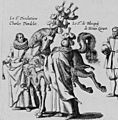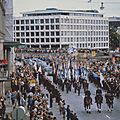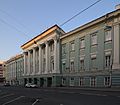State funeral facts for kids
A state funeral is a very special public ceremony. It honors people who were extremely important to their country. These funerals are usually for national leaders or heroes. They are a way for a whole country to say goodbye. Often, a day of national mourning is also announced. This means people take time to remember the person who passed away.

Contents
Who Gets a State Funeral?
State funerals are usually given to important political figures. These can include Presidents, Prime Ministers, or even Dictators. Other leaders like Governors, Mayors, Senators, or Vice Presidents might also receive one. Sometimes, members of a royal family are honored this way. Very famous military people or other national heroes can also have a state funeral. It depends on the country's traditions.
Why Are State Funerals Important?
State funerals are more than just a burial. They are a way for a country to show its respect. They also help people come together to grieve. These events often include parades, special music, and speeches. They highlight the person's life and their contributions to the nation. It's a moment of national unity and remembrance.
Related pages
Images for kids
-
Almost three million people attended Eva Perón's funeral in the streets of Buenos Aires.
-
State funeral of Néstor Kirchner at Casa Rosada.
-
State funeral of José Alencar, former Vice President of Brazil, at the Planalto Palace, Brasília.
-
The state funeral procession of B. J. Habibie at the Kalibata Heroes Cemetery, Jakarta on the 12th of September 2019
-
Pompa Funebris Albert VII
-
Funeral cortege of President Urho Kekkonen in Helsinki, 1986
-
The funeral procession of Henri Guisan in Lausanne (1960).
-
A drawing depicting the funeral cortege of Richard II of England leaving Pontefract Castle, 1468.
-
A drawing by William Camden depicting the funeral cortège of Queen Elizabeth I of England, 1603.
-
A drawing by Sebastián Muñoz depicting the lying in state of Queen Maria Luisa of Spain, 1689.
-
The funeral train of Abraham Lincoln departing Washington, D.C., en route to Springfield, Illinois, for interment, 1865.
-
A drawing depicting Abraham Lincoln's funeral procession in New York City en route from Washington D.C. to Springfield, Illinois, 1865.
-
The funeral procession of Thomas D'Arcy McGee during his state funeral in Ottawa, Canada, 1868.
-
The funeral procession of Edward VII of the United Kingdom in London, 1910.
-
The funeral procession of Liliuokalani in Honolulu, Hawaii, 1917.
-
The lying in state of Italian tenor Enrico Caruso at the Church San Francisco de Paulo in Naples, 1921.
-
A limbers and caissons carrying the remains of Warren G. Harding at the North Portico entrance of the White House before its procession down Pennsylvania Avenue en route to the United States Capitol Building, 1923.
-
The funeral procession for Japanese Admiral Isoroku Yamamoto in Tokyo, 1943.
-
A caisson carrying the remains of Franklin D. Roosevelt proceeds down Pennsylvania Avenue towards the United States Capitol, 1945.
-
A funeral parade of Marshal Mannerheim in Helsinki, Finland, on February 4, 1951. Helsinki Lutheran Cathedral on the background.
-
The funeral procession of former Argentinian First Lady Eva Peron, 1952.
-
The remains of John F. Kennedy lying in repose in the East Room of the White House, 1963.
-
The caparisoned, riderless horse named "Black Jack" during a departure ceremony held at the United States Capitol Building in conjunction with the state funeral of John F. Kennedy, 1963.
-
Robert F. Kennedy and Ethel Kennedy seen following Jacqueline Kennedy as she leaves the United States Capitol with John F. Kennedy, Jr. and Caroline Kennedy, after viewing the lying in state of John F. Kennedy, 1963.
-
The remains of Dwight D. Eisenhower being carried down the center steps of the east front of the United States Capitol Building by honor guards, 1969.
-
The funeral cortège of Queen Elizabeth The Queen Mother proceeds from the Palace of Westminster to Westminster Abbey, 2002.
-
A caisson carrying the remains of Ronald Reagan down Constitution Avenue en route to the United States Capitol, 2004.
-
The caparisoned, riderless horse named Sergeant York during the ceremonial funeral procession of Ronald Reagan, with a ceremonial sword attached to the saddle and a pair of the president's boots reversed in the stirrups, 2004.
-
A locomotive carrying the remains of George H. W. Bush en route to the College Station, 2018.
See also
 In Spanish: Funeral de Estado para niños
In Spanish: Funeral de Estado para niños






























